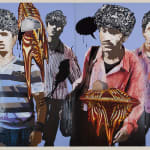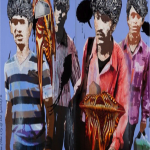Jitish Kallat b. 1974
Diptych, each: 84 x 60 in | 213.4 x 152.4 cm
The thing with folklore is it exists out of synch; not in a time, but many. It offers a sense of magic, a generational collapse, where copy after copy, retold and diluted, distils from ‘once upon a time’ an enduring and resolute truth. There’s no coincidence that Kallat approaches painting as erasure. His colours bleed and dapple, assert ghostly form, play tricks of light; concocted from watery elixirs, applied and scraped off, misted with corrosive liquids, each layer melting seamlessly into the next in biological and alchemical continuity. Their physicality isn’t in their substance, but rather the complete lack of it – a conception of place as indelible stain, palimpsests of uncountable intimate gestures. His canvases are less surfaces than screens: image receptors and transmitters, broadcasting fact and fiction in indistinguishable correlation.



